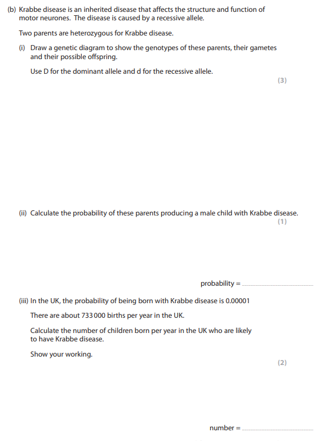(b) Krabbe disease is an inherited disease that affects the structure and function of motor neurones. The disease is caused by a recessive allele. Two parents are heterozygous for... (b) Krabbe disease is an inherited disease that affects the structure and function of motor neurones. The disease is caused by a recessive allele. Two parents are heterozygous for Krabbe disease. (i) Draw a genetic diagram to show the genotypes of these parents, their gametes and their possible offspring. Use D for the dominant allele and d for the recessive allele. (ii) Calculate the probability of these parents producing a male child with Krabbe disease. (iii) In the UK, the probability of being born with Krabbe disease is 0.0001. There are about 733000 births per year in the UK. Calculate the number of children born per year in the UK who are likely to have Krabbe disease. Show your working.

Understand the Problem
The question is asking to create a genetic diagram for two parents with Krabbe disease, calculate the probability of their child having the disease, and determine the number of children likely to have Krabbe disease based on UK statistics.
Answer
The probability is \( \frac{1}{4} \) and the number is \( 7.33 \).
Answer for screen readers
The probability of these parents producing a male child with Krabbe disease is ( \frac{1}{4} ).
The number of children born per year in the UK who are likely to have Krabbe disease is approximately ( 7.33 ).
Steps to Solve
-
Identify Genotypes of Parents Both parents are heterozygous for Krabbe disease. This means their genotypes can be represented as $Aa$, where $A$ is the dominant (healthy) allele and $a$ is the recessive (disease) allele.
-
Draw the Punnett Square Create a Punnett square to show the possible gametes from the two parents. Each parent can produce two types of gametes: $A$ and $a$.
A a A AA Aa a Aa aa -
Determine Offspring Genotypes From the Punnett square, we can determine the possible genotypes of the offspring:
- $AA$: healthy individual
- $Aa$: healthy carrier
- $aa$: affected by Krabbe disease
The fractions representing these genotypes are:
- $AA$: 1/4
- $Aa$: 1/2
- $aa$: 1/4
-
Calculate Probability of Male Child with Krabbe Disease The probability of these parents having a child with Krabbe disease ($aa$) is 1 out of 4, or $P(aa) = \frac{1}{4}$.
-
Calculate Number of Children Likely to Have Krabbe Disease Given the birth rate in the UK is approximately 733,000 births per year and the probability of being born with Krabbe disease is $0.00001$, use the formula:
$$ \text{number} = \text{total births} \times P(\text{Krabbe}) $$
Substituting the numbers:
$$ \text{number} = 733000 \times 0.00001 $$
The probability of these parents producing a male child with Krabbe disease is ( \frac{1}{4} ).
The number of children born per year in the UK who are likely to have Krabbe disease is approximately ( 7.33 ).
More Information
Krabbe disease is a rare genetic disorder, and understanding its inheritance helps illustrate how diseases can be passed down through generations. The use of Punnett squares is key in genetics for predicting traits in offspring.
Tips
- Misinterpreting Dominant and Recessive Alleles: Ensure you understand the difference between dominant ($A$) and recessive ($a$) alleles.
- Incorrect Probabilities: Remember to consider the correct number of possibilities when calculating probabilities using a Punnett square.
AI-generated content may contain errors. Please verify critical information